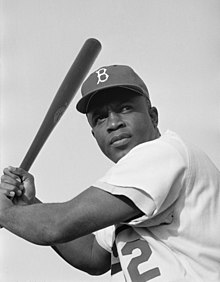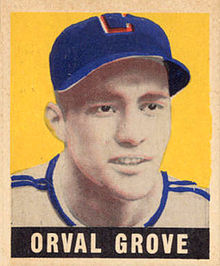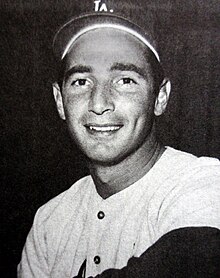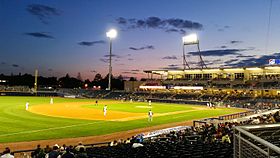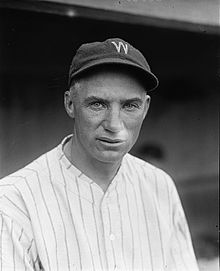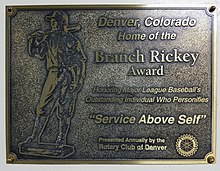Portal:Baseball
Portal maintenance status: (June 2018)
|
| Main page | Content, Categories & Topics | WikiProjects & Things you can do |
The Baseball Portal
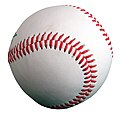
Baseball is a bat-and-ball sport played between two teams of nine players each, taking turns batting and fielding. The game occurs over the course of several plays, with each play generally beginning when a player on the fielding team, called the pitcher, throws a ball that a player on the batting team, called the batter, tries to hit with a bat. The objective of the offensive team (batting team) is to hit the ball into the field of play, away from the other team's players, allowing its players to run the bases, having them advance counter-clockwise around four bases to score what are called "runs". The objective of the defensive team (referred to as the fielding team) is to prevent batters from becoming runners, and to prevent runners advancing around the bases. A run is scored when a runner legally advances around the bases in order and touches home plate (the place where the player started as a batter).
The opposing teams switch back and forth between batting and fielding; the batting team's turn to bat is over once the fielding team records three outs. One turn batting for each team constitutes an inning. A game is usually composed of nine innings, and the team with the greater number of runs at the end of the game wins. Most games end after the ninth inning, but if scores are tied at that point, extra innings are usually played. Baseball has no game clock, though some competitions feature pace-of-play regulations such as the pitch clock to shorten game time.
Baseball evolved from older bat-and-ball games already being played in England by the mid-18th century. This game was brought by immigrants to North America, where the modern version developed. Baseball's American origins, as well as its reputation as a source of escapism during troubled points in American history such as the American Civil War and the Great Depression, have led the sport to receive the moniker of "America's Pastime"; since the late 19th century, it has been unofficially recognized as the national sport of the United States, though in modern times is considered less popular than other sports, such as American football. In addition to North America, baseball spread throughout the rest of the Americas and the Asia–Pacific in the 19th and 20th centuries, and is now considered the most popular sport in parts of Central and South America, the Caribbean, and East Asia, particularly in Japan, South Korea, and Taiwan. (Full article...)
 Featured articles - load new batch
Featured articles - load new batch
-
Image 1

WSNS-TV (channel 44) is a television station in Chicago, Illinois, United States, serving as the local outlet for the Spanish-language network Telemundo. It is owned and operated by NBCUniversal's Telemundo Station Group alongside NBC outlet WMAQ-TV (channel 5). The two stations share studios at the NBC Tower on North Columbus Drive in the city's Streeterville neighborhood and broadcast from the same transmitter atop the Willis Tower in the Chicago Loop.
WSNS-TV began broadcasting in 1970. Originally specializing in the automated display of news headlines, it evolved into Chicago's third full-fledged independent station, carrying movies, local sports, and other specialty programming. This continued until 1980, when WSNS became the Chicago-area station for ON TV, an over-the-air subscription television (STV) service owned by Oak Industries, which took a minority ownership stake in the station. While ON TV was successful in Chicago and the subscription system became the second-largest in the country by total subscribers, the rise of cable television precipitated the end of the business in 1985, with WSNS-TV as the last ON TV station standing. (Full article...) -
Image 2
Robert William Meusel (July 19, 1896 – November 28, 1977) was an American baseball left and right fielder who played in Major League Baseball (MLB) for eleven seasons from 1920 through 1930, all but the last for the New York Yankees. He was best known as a member of the Yankees' championship teams of the 1920s, nicknamed "Murderers' Row", during which time the team won its first six American League (AL) pennants and first three World Series titles.
Meusel, noted for his strong outfield throwing arm, batted fifth behind Baseball Hall of Famers Babe Ruth and Lou Gehrig. In 1925, he became the second Yankee, after Ruth, to lead the AL in home runs (33), runs batted in (138) and extra base hits (79). Nicknamed "Long Bob" because of his 6-foot, 3 inch (1.91 m) stature, Meusel batted .313 or better in seven of his first eight seasons, finishing with a .309 career average; his 1,009 RBI during the 1920s were the fourth most by any major leaguer, and trailed only Harry Heilmann's total of 1,131 among AL right-handed hitters. Meusel ended his career in 1930 with the Cincinnati Reds. He hit for the cycle three times, and was the second of six major leaguers to accomplish this feat as many as three times during a career. (Full article...) -
Image 3
Jack Roosevelt Robinson (January 31, 1919 – October 24, 1972) was an American professional baseball player who became the first African-American to play in Major League Baseball (MLB) in the modern era. Robinson broke the color line when he started at first base for the Brooklyn Dodgers on April 15, 1947. The Dodgers signing Robinson heralded the end of racial segregation in professional baseball, which had relegated black players to the Negro leagues since the 1880s.
Born in Cairo, Georgia, Robinson was raised in Pasadena, California. A four-sport student athlete at Pasadena Junior College and the University of California, Los Angeles, he was better known for football than he was for baseball, becoming a star college player with the UCLA Bruins football team. Following his college career, Robinson was drafted for service during World War II but was court-martialed for refusing to sit at the back of a segregated Army bus, eventually being honorably discharged. Afterwards, he signed with the Kansas City Monarchs of the Negro leagues, where he caught the eye of Branch Rickey, general manager of the Brooklyn Dodgers, who thought he would be the perfect candidate for breaking the color line in MLB. (Full article...) -
Image 4The Nashville Sounds Minor League Baseball team was established in Nashville, Tennessee, in 1978, after Larry Schmittou and a group of investors purchased the rights to operate an expansion franchise of the Double-A Southern League. The Sounds played their home games at Herschel Greer Stadium from its opening in 1978 until the end of the 2014 season. In 2015, the Sounds left Greer for First Tennessee Park, now known as First Horizon Park, a new facility located on the site of the historic Sulphur Dell ballpark, home to Nashville's minor league teams from 1885 to 1963.
The Sounds led all of Minor League Baseball in attendance in their inaugural season and continued to draw the Southern League's largest crowds in each of their seven years as members of the league. On the field, the team won six consecutive second-half division titles from 1979 to 1984 and won the Southern League championship twice: in 1979 as the Double-A affiliate of the Cincinnati Reds and again in 1982 as the Double-A affiliate of the New York Yankees. (Full article...) -
Image 5
James Francis Thorpe (Meskwaki: Wa-Tho-Huk, translated as "Bright Path"; May 22 or 28, 1887 – March 28, 1953) was an American athlete and Olympic gold medalist. A member of the Sac and Fox Nation, Thorpe was the first Native American to win a gold medal for the United States in the Olympics. Considered one of the most versatile athletes of modern sports, he won two Olympic gold medals in the 1912 Summer Olympics (one in classic pentathlon and the other in decathlon). He also played football (collegiate and professional), professional baseball, and professional basketball.
He lost his Olympic titles after it was found he had been paid for playing two seasons of semi-professional baseball before competing in the Olympics, thus violating the contemporary amateurism rules. In 1983, 30 years after his death, the International Olympic Committee (IOC) restored his Olympic medals with replicas, after ruling that the decision to strip him of his medals fell outside of the required 30 days. Official IOC records still listed Thorpe as co-champion in decathlon and pentathlon until 2022, when it was decided to restore him as the sole champion in both events. (Full article...) -
Image 6
Earvin "Magic" Johnson Jr. (born August 14, 1959) is an American businessman and former professional basketball player. Often regarded as the greatest point guard of all time, Johnson spent his entire career with the Los Angeles Lakers in the National Basketball Association (NBA). After winning a national championship with the Michigan State Spartans in 1979, Johnson was selected first overall in the 1979 NBA draft by the Lakers, leading the team to five NBA championships during their "Showtime" era. Johnson retired abruptly in 1991 after announcing that he had contracted HIV, but returned to play in the 1992 All-Star Game, winning the All-Star MVP Award. After protests against his return from his fellow players, he retired again for four years, but returned in 1996, at age 36, to play 32 games for the Lakers before retiring for the third and final time.
Known for his extraordinary court vision, passing abilities, and leadership, Johnson was one of the most dominant players of his era. His career achievements include three NBA Most Valuable Player Awards, three NBA Finals MVPs, nine All-NBA First Team designations, and twelve All-Star games selections. He led the league in regular season assists four times, and is the NBA's all-time leader in average assists per game in both the regular season (11.19 assists per game) and the playoffs (12.35 assists per game). He also holds the records for most career playoff assists and most career playoff triple-doubles. Johnson was the co-captain of the 1992 United States men's Olympic basketball team ("The Dream Team"), which won the Olympic gold medal in Barcelona; Johnson hence became one of eight players to achieve the basketball Triple Crown. After leaving the NBA in 1991, he formed the Magic Johnson All-Stars, a barnstorming team that traveled around the world playing exhibition games. (Full article...) -
Image 7

Ichiro Suzuki was the first high-profile NPB player (second overall) to use the posting system.
The posting system (ポスティングシステム, posutingu shisutemu) is a baseball player transfer system that operates between Nippon Professional Baseball (NPB) and Major League Baseball (MLB). Despite the drafting of the United States – Japanese Player Contract Agreement, unveiled in 1967 to regulate NPB players moving to MLB, problems began to arise in the late 1990s. Some NPB teams lost star players without compensation, an issue highlighted when NPB stars Hideo Nomo and Alfonso Soriano left to play in MLB after using loopholes to void their existing contracts. A further problem was that NPB players had very little negotiating power if their teams decided to deal them to MLB, as when pitcher Hideki Irabu was traded to an MLB team for which he had no desire to play. In 1998, the Agreement was rewritten to address both problems; the result was dubbed the "posting system".
Under this system, when an NPB player is "posted", his NPB team notifies the MLB Commissioner, with the posting fee based on the type of contract a player signs and its value. For minor-league contracts, the fee is a flat 25% of contract's value; for MLB contracts, the fee is based on the value of the contract that the posted player eventually signs. The player is then given 30 days to negotiate with any MLB team willing to pay the NPB team's posting fee. If the player agrees on contract terms with a team before the 30-day period has expired, the NPB team receives the posting fee from the signing MLB team as a transfer fee, and the player is free to play in MLB. If no MLB team comes to a contract agreement with the posted player, then no fee is paid, and the player's rights revert to his NPB team. The current process replaced one in which MLB held a silent auction during which MLB teams submitted sealed, uncapped bids in an attempt to win the exclusive negotiating rights with the posted player for a period of 30 days. Once the highest bidding MLB team was determined, the player could then only negotiate with that team. (Full article...) -
Image 8
Orval Leroy Grove (August 29, 1919 – April 20, 1992) was an American professional baseball pitcher in Major League Baseball who played for ten seasons in the American League with the Chicago White Sox. In 207 career games, Grove pitched 1,176 innings and posted a win–loss record of 63–73, with 66 complete games, 11 shutouts, and a 3.78 earned run average (ERA).
The only freshman on the Proviso Township High School varsity baseball team, Grove's pitching ability attracted the attention of the White Sox. After signing with the team in 1937, Grove moved between the major leagues and minor leagues for a few seasons until 1943, when he found a solid place in the White Sox's pitching rotation. Grove had a career-year in 1943, finishing the season with career-bests in ERA, wins, and complete games; in 1944, he made his only All-Star appearance. (Full article...) -
Image 9

Hershiser pitching for the Dodgers in 1993
During the 1988 Major League Baseball season, pitcher Orel Hershiser of the Los Angeles Dodgers set the MLB record for consecutive scoreless innings pitched. Over 59 consecutive innings, opposing hitters did not score a run against Hershiser. During the streak, he averted numerous high-risk scoring situations. The streak spanned from the sixth inning of an August 30 game against the Montreal Expos to the 10th inning of a September 28 game against the San Diego Padres. The previous record of 58+2⁄3 innings was set by former Dodger pitcher Don Drysdale in 1968; as the team's radio announcer, Drysdale called Hershiser's streak as he pursued the new record. Pundits have described the streak as among the greatest records in baseball history, with one pundit ranking it among the greatest individual feats in American sports.
During the streak, the Elias Sports Bureau changed its criteria for the official consecutive scoreless innings record for starting pitchers from including fractional innings in which one or two outs had been recorded to counting only complete scoreless innings. Since the streak was active at the end of the 1988 season, it could have spanned two separate seasons. However, Hershiser yielded a run in his first inning of work in the 1989 season against the Cincinnati Reds, thus ending the streak at 59 consecutive scoreless innings pitched. The streak includes only innings pitched in the regular season, excluding eight scoreless innings Hershiser pitched to start Game 1 of the 1988 National League Championship Series on October 4 (unofficially extending his streak to 67 combined innings). Although he completed the ninth inning in each start, the streak's final game lasted 16 innings, of which he pitched only the first 10. Thus, Hershiser did not match Drysdale's record of six consecutive complete game shutouts. Like Drysdale's streak, the penultimate game of Hershiser's streak was a Dodgers–Giants game that featured a controversial umpire's ruling that saved the streak. (Full article...) -
Image 10
Sanford Koufax (/ˈkoʊfæks/; né Braun; born December 30, 1935), nicknamed "the Left Arm of God", is an American former baseball pitcher who played 12 seasons in Major League Baseball (MLB) for the Brooklyn/Los Angeles Dodgers from 1955 to 1966. Widely regarded as one of the greatest pitchers in baseball history, Koufax was the first three-time winner of the Cy Young Award, each time winning unanimously and the only pitcher to do so when a single award was given for both the leagues; he was also named the National League Most Valuable Player in 1963. Retiring at the age of 30 due to chronic pain in his pitching elbow, Koufax was elected to the Baseball Hall of Fame in his first year of eligibility in 1972 at the age of 36, the youngest player ever elected.
Born in Brooklyn, New York, Koufax was primarily a basketball player in his youth and had pitched in only a few games before signing with the Brooklyn Dodgers at age 19. Due to the bonus rule he signed under, Koufax never pitched in the minor leagues. His lack of pitching experience caused manager Walter Alston to distrust Koufax, who saw inconsistent playing time during his first six seasons. As a result, though he often showed flashes of brilliance, Koufax struggled early on. Frustrated with the way he was being managed by the Dodgers, he almost quit after the 1960 season. After making adjustments prior to the 1961 season, Koufax quickly rose to become the most dominant pitcher in the major leagues, as well as the first major sports star on the West Coast. He was an All-Star in each of his last six seasons, leading the National League (NL) in earned run average each of his last five years, in strikeouts four times, and in wins and shutouts three times each. He was the first pitcher in the live-ball era to post an earned run average below 2.00 in three different qualifying seasons, and the first ever to record a 300-strikeout season three times. (Full article...) -
Image 11
First Horizon Park, formerly known as First Tennessee Park, is a baseball park in downtown Nashville, Tennessee, United States. The home of the Triple-A Nashville Sounds of the International League, it opened on April 17, 2015, and can seat up to 10,000 people. It replaced the Sounds' former home, Herschel Greer Stadium, where the team played from its founding in 1978 through 2014.
The park was built on the site of the former Sulphur Dell, a minor league ballpark in use from 1885 to 1963. It is located between Third and Fifth Avenues on the east and west (home plate, the pitcher's mound, and second base are directly in line with Fourth Avenue to the stadium's north and south) and between Junior Gilliam Way and Harrison Street on the north and south. The Nashville skyline can be seen from the stadium to the south. (Full article...) -
Image 12
Stanley Anthony Coveleski (born Stanislaus Kowalewski, July 13, 1889 – March 20, 1984) was an American right-handed pitcher in Major League Baseball who played for four American League (AL) teams between 1912 and 1928, primarily the Cleveland Indians. The star of the Indians pitching staff, he won over 20 games each year from the war-shortened 1918 season through 1921, leading the AL in shutouts twice and in strikeouts and earned run average (ERA) once each during his nine years with the club. The star of the 1920 World Series, he led the Indians to their first title with three complete-game victories, including a 3–0 shutout in the Game 7 finale. Traded to the Washington Senators after the 1924 season, he helped that club to its second AL pennant in a row with 20 victories against only 5 losses, including a 13-game winning streak, while again leading the league in ERA.
Coveleski followed in the footsteps of his brother Harry as a major league pitcher. But after making his debut with the Philadelphia Athletics in 1912, he was sidetracked by three more seasons in the minor leagues before joining the Indians in 1916, and won only 13 major league games before turning 27. Coveleski specialized in throwing the spitball, where the pitcher alters the ball with a foreign substance such as chewing tobacco. It was legal when his career began but prohibited in 1920, with Coveleski being one of 17 pitchers permitted to continue throwing the pitch. In 450 career games, Coveleski pitched 3,082 innings and posted a record of 215–142, with 224 complete games, 38 shutouts, and a 2.89 ERA. He set Cleveland records of 172 wins, 2,502+1⁄3 innings and 305 starts, which were later broken by Mel Harder and Willis Hudlin. He was inducted into the Baseball Hall of Fame in 1969. (Full article...) -
Image 13
Stanley Frank Musial (/ˈmjuːziəl, -ʒəl/; born Stanislaw Franciszek Musial; November 21, 1920 – January 19, 2013), nicknamed "Stan the Man", was an American baseball outfielder and first baseman. Widely considered to be one of the greatest and most consistent hitters in baseball history, Musial spent 22 seasons in Major League Baseball (MLB), playing for the St. Louis Cardinals, from 1941 to 1944 and from 1946 to 1963. He was inducted into the Baseball Hall of Fame in 1969 in his first year of eligibility.
Musial was born in Donora, Pennsylvania, where he frequently played baseball informally or in organized settings, and eventually played on the baseball team at Donora High School. Signed to a professional contract by the St. Louis Cardinals as a pitcher in 1938, Musial was converted into an outfielder and made his major league debut in 1941. Noted for his unique batting stance, he quickly established himself as a consistent and productive hitter. In his first full season, 1942, the Cardinals won the World Series. The following year, he led the NL in six different offensive categories and earned his first MVP award. He was also named to the NL All-Star squad for the first time; he appeared in every All-Star game in every subsequent season he played. Musial won his second World Series championship in 1944, then missed the 1945 season while serving in the Navy. After completing his military service, Musial returned to baseball in 1946 and resumed his consistent hitting. That year he earned his second MVP award and third World Series title. His third MVP award came in 1948, when he finished one home run short of winning baseball's Triple Crown. After struggling offensively in 1959, Musial used a personal trainer to help maintain his productivity until he decided to retire in 1963. (Full article...) -
Image 14The 2004 World Series was the championship series of Major League Baseball's (MLB) 2004 season. The 100th edition of the World Series, it was a best-of-seven playoff between the American League (AL) champion Boston Red Sox and the National League (NL) champion St. Louis Cardinals; the Red Sox swept the Cardinals in four games. The series was played from October 23 to 27, 2004, at Fenway Park and Busch Memorial Stadium, broadcast on Fox, and watched by an average of just under 25.5 million viewers. The Red Sox's World Series championship was their first since 1918, ending the Curse of the Bambino.
The Cardinals earned their berth into the playoffs by winning the NL Central division title, and had the best win–loss record in the NL. The Red Sox won the AL wild card to earn theirs. The Cardinals reached the World Series by defeating the Los Angeles Dodgers in the best-of-five NL Division Series and the Houston Astros in the best-of-seven NL Championship Series. The Red Sox defeated the Anaheim Angels in the AL Division Series. After trailing three games to none to the New York Yankees in the AL Championship Series, the Red Sox came back to win the series, advancing to their first World Series since 1986. The Cardinals made their first appearance in the World Series since 1987. With the New England Patriots winning Super Bowl XXXVIII, the World Series victory made Boston the first city to have Super Bowl and World Series championship teams in the same year (2004) since Pittsburgh in 1979. The Red Sox became the third straight wild card team to win the World Series; the Anaheim Angels won in 2002 and the Florida Marlins won in 2003. (Full article...) -
Image 15

On July 10, 1932, the Philadelphia Athletics beat the Cleveland Indians 18–17 in 18 innings in a Major League Baseball game played at League Park in Cleveland. Several major-league records were set during the game; for example, Johnny Burnett of the Indians became the only player to hit safely nine (or even eight) times in a game, while Cleveland's 33 hits and the teams' combined 58 hits are also single-game records. Pitcher Eddie Rommel secured the win for the Athletics, pitching an American League-record 17 innings in relief after Philadelphia's Lew Krausse gave up three runs in the first inning. The 29 hits Rommel allowed are a major-league record; the 14 runs against him are the most given up by a winning pitcher.
Coming into the game, the Athletics, who were the three-time defending American League champions, trailed the New York Yankees in the standings by 71⁄2 games. Sunday baseball was still illegal in Philadelphia, forcing the Athletics to make one-game road trips on some Sundays, including July 10. With his pitching staff exhausted by six games in the previous three days, the owner and manager of the Athletics, Connie Mack, took only two pitchers on the train trip to Cleveland, giving the rest of the staff the day off. With no chance of being relieved except by a position player, Rommel pitched with mixed effectiveness, giving up six runs in the seventh inning but only two runs in the final nine innings of the game. He aided his own cause by getting three hits in seven at bats. Cleveland's Wes Ferrell took the loss after Jimmie Foxx got his sixth hit of the game and then scored. Foxx had already batted in eight runs, having hit three home runs and accumulated sixteen total bases, tying a record that has since been broken. (Full article...)
General images - load new batch
-
Image 1An Afghan girl playing baseball in August 2002 (from Baseball)
-
Image 2Jackie Robinson in 1945, with the era's Kansas City Royals, a barnstorming squad associated with the Negro American League's Kansas City Monarchs (from History of baseball)
-
Image 32013 World Baseball Classic championship match between the Dominican Republic and Puerto Rico, March 20, 2013 (from Baseball)
-
Image 5The strike zone determines the result of most pitches, and varies in vertical length for each batter. (from Baseball)
-
Image 6Baserunners generally stand a short distance away from their base between pitches, preparing themselves to either go back or steal the next base. (from Baseball rules)
-
Image 7A pitcher handing off the ball after being taken out of the game during a mound meeting. (from Baseball)
-
Image 9A batter follows through after swinging at a pitched ball. (from Baseball rules)
-
Image 10Sadaharu Oh managing the Japan national team in the 2006 World Baseball Classic. Playing for the Central League's Yomiuri Giants (1959–80), Oh set the professional world record for home runs. (from Baseball)
-
Image 11Pick-off attempt on runner (in red) at first base (from Baseball rules)
-
Image 12The typical motion of a right-handed pitcher (from Baseball rules)
-
Image 13Japanese-Americans spectating a World War II-era game while in an internment camp. America's ties to immigrants and to Japan have been deeply shaped by a shared baseball heritage. (from History of baseball)
-
Image 14The strike zone, which determines the outcome of most pitches, varies in vertical length depending on the batter's typical height while swinging. (from Baseball rules)
-
Image 15Cover of Official Base Ball Rules, 1921 edition, used by the American League and National League (from Baseball rules)
-
Image 16A New York Yankees batter (Andruw Jones) and a Boston Red Sox catcher at Fenway Park (from Baseball)
-
Image 18Fenway Park, home of the Boston Red Sox. The Green Monster is visible beyond the playing field on the left. (from Baseball)
-
Image 21The American Tobacco Company's line of baseball cards featured shortstop Honus Wagner of the Pittsburgh Pirates from 1909 to 1911. In 2007, the card shown here sold for $2.8 million. (from Baseball)
-
Image 221906 World Series, infielders playing "in" for the expected bunt and the possible play at the plate with the bases loaded (from Baseball rules)
-
Image 23Cy Young—the holder of many major league career marks, including wins and innings pitched, as well as losses—in 1908. MLB's annual awards for the best pitcher in each league are named for Young. (from Baseball)
-
Image 24Jackie Robinson in 1945, with the era's Kansas City Royals, a barnstorming squad associated with the Negro American League's Kansas City Monarchs (from Baseball)
-
Image 26Baseball games sometimes end in a walk-off home run, with the batting team usually gathering at home plate to celebrate the scoring of the winning run(s). (from Baseball rules)
-
Image 27A first baseman receives a pickoff throw, as the runner dives back to first base. (from Baseball)
-
Image 28A well-worn baseball (from Baseball)
-
Image 29A runner sliding into home plate and scoring. (from Baseball)
-
Image 31In May 2010, the Philadelphia Phillies' Roy Halladay pitched the 20th major league perfect game. That October, he pitched only the second no-hitter in MLB postseason history. (from History of baseball)
-
Image 32Defensive positions on a baseball field, with abbreviations and scorekeeper's position numbers (not uniform numbers) (from Baseball)
-
Image 33Rickey Henderson—the major leagues' all-time leader in runs and stolen bases—stealing third base in a 1988 game (from Baseball)
-
Image 34A game from the Cantigas de Santa Maria, c. 1280, involving tossing a ball, hitting it with a stick and competing with others to catch it (from History of baseball)
-
Image 35Alexander Cartwright, father of modern baseball (from History of baseball)
-
Image 36The NL champion New York Giants baseball team, 1913. Fred Merkle, sixth in line, had committed a baserunning gaffe in a crucial 1908 game that became famous as Merkle's Boner. (from History of baseball)
-
Image 37Sadaharu Oh managing the Japan national team in the 2006 World Baseball Classic. Playing for the Central League's Yomiuri Giants (1959–80), Oh set the professional world record for home runs with 868. (from History of baseball)
-
Image 38By the 1860s Civil War, baseball (bottom) had overtaken its fellow bat-and-ball sport cricket (top) in popularity within the United States. (from History of baseball)
-
Image 39The standard fielding positions (from Baseball rules)
-
Image 42Pesäpallo, a Finnish variation of baseball, was invented by Lauri "Tahko" Pihkala in the 1920s, and after that, it has changed with the times and grown in popularity. Picture of Pesäpallo match in 1958 in Jyväskylä, Finland. (from Baseball)
-
Image 43Diagram of a baseball field Diamond may refer to the square area defined by the four bases or to the entire playing field. The dimensions given are for professional and professional-style games. Children often play on smaller fields. (from Baseball)
-
Image 44Pitchers are generally substituted during mound visits (team gatherings at the pitcher's mound). (from Baseball rules)
 Good articles - load new batch
Good articles - load new batch
-
Image 1
Tyler Lee Clippard (born February 14, 1985) is an American former professional baseball pitcher. He played in Major League Baseball (MLB) for the New York Yankees, Washington Nationals, Oakland Athletics, New York Mets, Arizona Diamondbacks, Chicago White Sox, Houston Astros, Toronto Blue Jays, Cleveland Indians, and Minnesota Twins.
After playing baseball at J. W. Mitchell High School in New Port Richey, Florida, the Yankees drafted Clippard in the ninth round of the 2003 MLB draft. He debuted with the Yankees as a starting pitcher in 2007. After being traded to the Washington Nationals he was named to the MLB All-Star Game in 2011 and 2014 and won the MLB Delivery Man of the Month Award in June 2011. (Full article...) -
Image 2
Eric Kevin Bruntlett (born March 29, 1978) is an American former professional baseball utility player. Between 2003 and 2009, he played seven seasons in Major League Baseball (MLB) for the Houston Astros and Philadelphia Phillies.
Born in Lafayette, Indiana, Bruntlett was a shortstop and second baseman for William Henry Harrison High School, with whom he won a state baseball championship in 1995. He played four seasons of college baseball with the Stanford Cardinal, becoming the team's starting shortstop in 1999. After two College World Series appearances, Bruntlett signed with the Astros, who had selected him in the ninth round of the 2000 MLB draft. (Full article...) -
Image 3

Harold Arthur "Hal" Peck (April 20, 1917 – April 13, 1995) was an American professional baseball right fielder. He played seven seasons in Major League Baseball (MLB) from 1943 to 1949 for the Brooklyn Dodgers, Philadelphia Athletics, and Cleveland Indians. In 355 career games, Peck recorded a batting average of .279 and accumulated 15 home runs and 112 runs batted in (RBI).
Born in Big Bend, Wisconsin, Peck began to play professional baseball in 1938. He spent two years in the lower minor leagues, then spent the better part of five years with the Milwaukee Brewers of the American Association. In 1942, Peck lost two toes in a shooting accident, but despite the injury was able to continue playing baseball. He made his major league debut in 1943 with the Brooklyn Dodgers, then joined the Philadelphia Athletics 1944. He spent three seasons with them, and was an everyday player in 1945. Peck was then traded to the New York Yankees and the Cleveland Indians. He achieved a career high in games played with 114 in 1947, and spent 1948 and 1949 as a pinch hitter. Peck also played a game in the 1948 World Series for the Indians. After being traded from the Indians after the 1949 season, he retired from baseball, and died in 1995. (Full article...) -
Image 4
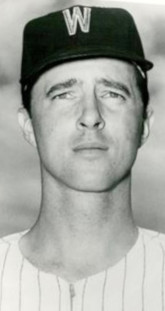
Peter Willits Burnside (July 2, 1930 – August 26, 2022) was an American professional baseball player and left-handed pitcher who appeared in 196 Major League Baseball games in 1955 and from 1957 to 1963 for the New York / San Francisco Giants, Detroit Tigers, Washington Senators and Baltimore Orioles. He was listed as 6 feet 2 inches (1.88 m) tall and 180 pounds (82 kg).
Burnside grew up in Evanston, Illinois, rooting for the Chicago Cubs. He signed with the New York Giants out of high school, under the agreement that he could earn his degree at Dartmouth College while pitching in their minor league system. After a stint in the United States Army, Burnside made his major league debut in 1955, picking up his first win the same year and impressing Carl Hubbell, Giants' Hall of Fame pitcher and farm director. Injuries prevented Burnside's return to the big leagues until 1957, and he only won one of the 16 games he pitched for the Giants in 1957 and 1958. Acquired by the Detroit Tigers for 1959, Burnside spent the whole season in their bullpen that year. Getting a chance to start with the team in 1960, he had a career-high seven wins before being selected by the Washington Senators in the expansion draft. (Full article...) -
Image 5Babe Ruth lying in state in the rotunda of the old Yankee Stadium
Babe Ruth died on August 16, 1948, from a type of throat cancer. He underwent hormone therapy, and surgery in an attempt to treat his cancer. He was also one of the first cancer patients to receive sequential radiation and chemotherapy treatment. The treatments were not successful.
His funeral took place over three days, from August 17 to August 19, 1948. Ruth was a well-known Major League Baseball player who played for the New York Yankees for fifteen years. His funeral included a two-day open casket funeral at Yankee Stadium, a mass at St. Patrick's Cathedral and a burial at the Gate of Heaven Cemetery. The funeral events were attended by many prominent people. A total of 57 honorary pallbearers were appointed for his funeral. (Full article...) -
Image 6Stephenson with the Cincinnati Reds in 2021
Tyler Robert Stephenson (born August 16, 1996) is an American professional baseball catcher for the Cincinnati Reds of Major League Baseball (MLB). The Reds selected him in the first round, 11th overall, of the 2015 MLB Draft.
Born in Atlanta and raised in Kennesaw, Georgia, Stephenson played for the baseball team at Kennesaw Mountain High School, where he began calling pitches during his freshman season. The Reds drafted Stephenson out of high school, and he chose to forego his college baseball commitment to begin his professional career in their farm system. Stephenson suffered significant injuries during consecutive minor league seasons in 2016 and 2017, but he remained healthy the next two years and received praise from Southern League managers as a defensive catcher. (Full article...) -
Image 7
Jonathan Ray Lieber (born April 2, 1970) is an American former professional baseball pitcher. He stands 6 feet 2 inches (1.88 m) tall and weighs 240 pounds (110 kg). He played in Major League Baseball (MLB) for the Pittsburgh Pirates (1994–1998), Chicago Cubs (1999–2002 and 2008), New York Yankees (2004), and Philadelphia Phillies (2005–2007). He batted left-handed and threw right-handed, and utilized a fastball, a slider, and a changeup for his pitches. In a 14-season career, Lieber compiled a 131–124 record with 1,553 strikeouts and a 4.27 ERA in 2,198 innings pitched.
Lieber attended the University of South Alabama, helping them win the Sun Belt Conference Championship. He was drafted by the Kansas City Royals in the second round of the 1992 Major League Baseball Draft, but he was traded to the Pittsburgh Pirates the following season before even throwing a pitch in the major leagues. He made his debut in 1994 and was named the Pirates' Opening Day starter in 1995, but it was not until 1997 that he became a full-time major league starter. He was traded to the Chicago Cubs following the 1998 season. In 2000, he led the National League (NL) with 251 innings pitched. He had his best season in 2001, winning 20 games while losing just six. Lieber underwent Tommy John surgery in 2002 and missed the entire 2003 season. In 2004, he pitched for the New York Yankees, reaching the playoffs for the only time in his career. He signed with the Philadelphia Phillies in 2005 and tied for fifth in the NL with 17 wins. Injuries cut into his playing time over the next three years; he finished his career as a reliever with the Cubs in 2008. (Full article...) -
Image 8Moneyball is a 2011 American biographical sports drama film. It was directed by Bennett Miller with a script by Steven Zaillian and Aaron Sorkin from a story by Stan Chervin. The film is based on the 2003 nonfiction book, Moneyball: The Art of Winning an Unfair Game by Michael Lewis. The book is an account of the Oakland Athletics baseball team's 2002 season and their general manager Billy Beane's attempts to assemble a competitive team with half (or even a third) as much money as his rivals. In the film, Beane and his deputy Peter Brand scout the major leagues for undervalued talent by taking a sophisticated sabermetric approach to scouting and analyzing players, triggering skepticism and resentment within the baseball community.
Columbia Pictures bought the rights to Lewis's book in 2004, hiring Chervin to write the screenplay. David Frankel was initially set to direct with Zaillian now writing the screenplay, but was soon replaced by Steven Soderbergh, who planned to make the film in a semi-documentary style featuring interviews from real athletes, and having the real players and coaches on the team portray themselves. But before its July 2009 filming start, the film was put in turnaround due to creative differences between Soderbergh and Sony over a last-minute script rewrite. Soderbergh exited, and Miller was hired to direct, with Pitt becoming a producer and Sorkin hired for rewrites. Filming began in July 2010 at various stadiums such as Dodger Stadium and Oakland Coliseum. (Full article...) -
Image 9
Mark William Prior (born September 7, 1980) is an American former professional baseball pitcher and current coach. A onetime top prospect of the Chicago Cubs, he pitched for the team from 2002 to 2006 in a career that was marred by injuries. In his prime, his repertoire of pitches included a mid-90s mph fastball, a curveball, and a changeup. He is currently the pitching coach for the Los Angeles Dodgers.
Born and raised in San Diego, California, Prior engaged Tom House as his pitching tutor in high school. A career at the University of Southern California, where he won the Golden Spikes Award, saw him become one of the top prospects in the 2001 MLB draft, when he was the second overall pick by the Cubs. He made only six appearances in the minor leagues before debuting with the team in 2002. In 2003, he finished third in National League (NL) Cy Young Award voting, ranking among the leaders with 18 wins, a 2.43 earned run average (ERA), and 245 strikeouts. Helping the Cubs win the NL Central title, he outpitched Greg Maddux in the NL Division Series and won Game 2 of the NL Championship Series, but he was on the mound for Game 6 when Steve Bartman prevented Moisés Alou from catching a foul ball. (Full article...) -
Image 10
Andrés Yungo Torres Feliciano Jr., (born January 26, 1978) is an American former professional baseball center fielder. He stands 5 feet 10 inches (1.78 m) tall and weighs 195 pounds (88 kg) and is a switch-hitter. He played in Major League Baseball (MLB) for the Detroit Tigers, Texas Rangers, New York Mets, and San Francisco Giants.
Born in New Jersey, Torres grew up in Puerto Rico before returning to the United States to attend Miami-Dade Community College. He was a track star at Miami-Dade and did not begin playing baseball until later. In 1998, he was drafted by the Detroit Tigers in the fourth round of the 1998 Major League Baseball draft. Torres played in their minor leagues until 2002, when he made his major league debut. In 2003, he got a chance to be the everyday center fielder for the Tigers, but after 23 games they chose to replace him. He played only three games for them in 2004 before he was outrighted to the minors and released upon request. In 2005, Torres resurfaced with the Texas Rangers but only appeared in eight games. He spent the next three years in the minor leagues. (Full article...) -
Image 11Wilburn Edward "Eddy" Furniss III (born September 18, 1975) is an American former professional baseball first baseman and designated hitter. A standout college baseball player for Louisiana State University (LSU), Furniss has been inducted into the College Baseball Hall of Fame, the LSU Athletic Hall of Fame, and the Louisiana Sports Hall of Fame. He is the 10th athlete, and 2nd baseball player, in LSU history to have his number retired.
With the LSU Tigers, Furniss was a two-time College World Series champion and a two-time All-American. He won the Dick Howser Trophy as college baseball's best player in 1998, and set Southeastern Conference (SEC) records in numerous offensive categories, including home runs and runs batted in (RBIs). He was among the National Collegiate Athletic Association's all-time leaders in home runs and RBIs at the time he graduated from college. (Full article...) -
Image 12George H. "Hoss" Hobson (May 4, 1908 – November 19, 2001) was an American athlete and sports coach. After playing college football for Alabama State, Hobson began a coaching career at several high schools, leading his teams to four state championships. In c. 1941, he began his tenure at Alabama A&M University, for which he was best known. He served as head football coach from 1942 to 1959, and was also the athletic director for many years. In the latter position, he revived the school's baseball team and added the sports of basketball, tennis, and golf, serving as the head coach of each for a time. Hobson later served as commissioner of the SIAC and was inducted into both the NACDA and Alabama A&M Halls of Fame. (Full article...)
-
Image 13Michael Curtis Darr (March 21, 1976 – February 15, 2002) was an American Major League Baseball (MLB) outfielder who played from 1999 through 2001 for the San Diego Padres. He was the son of Mike Darr, Sr., who pitched in one game for the Toronto Blue Jays in 1977. Darr batted left-handed but threw right-handed.
Born and raised in Corona, California, Darr was a second-round draft pick of the Detroit Tigers out of high school in 1994. Traded to the San Diego Padres before the 1997 season, he made his MLB debut with the team in 1999. After playing 58 games with the Padres in 2000, Darr was named the team's Opening Day right fielder in 2001, serving as the everyday player at that position until August. (Full article...) -
Image 14
Paul Raymond "Shorty" Des Jardien (August 24, 1893 – March 7, 1956) was an American football, baseball and basketball player. He played for the University of Chicago where he was selected as the first-team All-American center in both 1913 and 1914 and also pitched a no-hitter for the baseball team. He later played professional baseball for the Cleveland Indians and professional football for the Cleveland Indians (1916), Hammond Pros (1919), Chicago Tigers (1920) and Minneapolis Marines (1922). He was inducted into the College Football Hall of Fame in 1955. (Full article...) -
Image 15

The New York Yankees are an American professional baseball team based in the New York City borough of the Bronx. The Yankees compete in Major League Baseball (MLB) as a member club of the American League (AL) East Division. They are one of two major league clubs based in New York City alongside the National League (NL)'s New York Mets. The team was founded in 1903 when Frank Farrell and Bill Devery purchased the franchise rights to the defunct Baltimore Orioles (no relation to the current team of the same name) after it ceased operations and used them to establish the New York Highlanders. The Highlanders were officially renamed the Yankees in 1913.
The team is owned by Yankee Global Enterprises, a limited liability company that is controlled by the family of the late George Steinbrenner. Steinbrenner purchased the team from CBS in 1973. Currently, Brian Cashman is the team's general manager, Aaron Boone is the team's field manager, and Aaron Judge is the team captain. The team's home games were played at the original Yankee Stadium in the Bronx from 1923 to 1973 and from 1976 to 2008. In 1974 and 1975, the Yankees shared Shea Stadium with the Mets, in addition to the New York Jets and the New York Giants. In 2009, they moved into a new ballpark of the same name that was constructed adjacent to the previous facility, which was closed and demolished. The team is perennially among the leaders in MLB attendance. (Full article...)
Did you know (auto-generated) - load new batch

- ... that thirty years after playing his first season for the Miami Hurricanes, J. D. Arteaga became the team's head coach in 2024?
- ... that the parents of Bob Glenalvin insisted that he play baseball under an assumed name?
- ... that one Baltimore Orioles player compared the 2024 Major League Baseball jerseys to knockoffs from TJ Maxx?
- ... that Jenny Cavnar is the first female primary play-by-play announcer in Major League Baseball history?
- ... that while waiting for an interview, journalist Rod Beaton was involved in a shoving incident with baseball player Barry Bonds?
- ... that Helene Hathaway Britton, the first woman to own a Major League Baseball team, was unsuccessfully pressured by other club owners to sell the team?
- ... that the six highest Minor League Baseball season attendance counts were all at Sahlen Field?
- ... that labor lawyer Dick Moss argued the 1975 case which resulted in the establishment of free agency in Major League Baseball?
Quotes
| Always go to other people's funerals, otherwise they won't come to yours. |
 Featured lists - load new batch
Featured lists - load new batch
-
Image 1
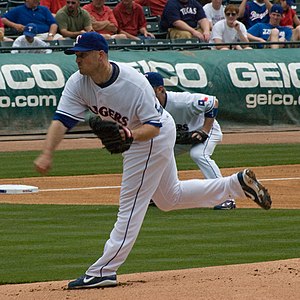
Jason Jennings is the only one of Rockies first-round draft picks to win the Rookie of the Year Award (2002).
The Colorado Rockies are a Major League Baseball (MLB) franchise based in Denver, Colorado. They play in the National League West division. The Rockies have participated in MLB's annual June draft since 1992. Officially known as the "First-Year Player Draft", the Rule 4 Draft is MLB's primary mechanism for assigning players from high schools, colleges, and other amateur clubs to its franchises. The draft order is determined based on the previous season's standings, with the team possessing the worst record receiving the first pick. In addition, teams which lost free agents in the previous off-season may be awarded compensatory or supplementary picks. Since the franchise was established as an expansion team in 1992, the Rockies have selected 31 players in the first round. The First-Year Player Draft is unrelated to the 1992 expansion draft through which the Rockies filled their roster.
Of the 31 players selected in the first round by the Rockies, 18 have been pitchers, the most of any position; 12 of these have been right handed, and 6 have been left-handed. The Rockies have also selected six outfielders, four shortstops, and one player each at catcher, first base, and third base. The Rockies have never selected a second baseman in the first round. The Rockies have drafted 16 players out of high school, and 14 out of college. Colorado has drafted seven players from high schools or colleges in the state of California, with five coming from Texas and three from Tennessee. The Rockies' 2002 selection—Jeff Francis—is the only selection from outside the United States.
None of the Rockies' first-round picks have won a World Series championship with the team. One pick has been elected to the Hall of Fame, Todd Helton who was the 8th overall pick in 1995. The Rockies' first-round selection in 1999—Jason Jennings—won the MLB Rookie of the Year award with the franchise in 2002, his first full season in the Major Leagues. Todd Helton—the Rockies' 1995 selection—has won four Silver Slugger Awards and three Gold Gloves, as well as being named to five All-Star teams. Casey Weathers, the Rockies' 2007 selection, won a bronze medal in baseball with the United States team at the 2008 Summer Olympics. The Rockies have never held the first overall pick in the draft, but held the second overall pick once, which they used in 2006 to select Greg Reynolds. (Full article...) -
Image 2

The Philadelphia Phillies are a Major League Baseball (MLB) team based in Philadelphia, Pennsylvania. The Phillies compete in MLB as a member club of the National League (NL) East division. In the franchise's history, the owners and ownership syndicates of the team have employed 11 general managers (GMs) and appointed 15 team presidents. The GM controls player transactions, hiring and firing of the coaching staff, and negotiates with players and agents regarding contracts. The team president is the representative for the owner or the ownership group within the front office and is responsible for overseeing the team's staff, minor league farm system, and scouting.
The longest-tenured general manager is Paul Owens, with 11 years of service to the team in that role, from 1972 to 1983. Owens also served as the team manager in 1972, and from 1983 to 1984. After this time, he served as a team executive until 2003, and was inducted into the Philadelphia Baseball Wall of Fame in recognition of his services. The longest-tenured owner is Bob Carpenter, Jr., who was the team's primary shareholder from 1943 to 1972. He appointed the team's first general manager, Herb Pennock, during his tenure. In combination with his son, Ruly, the Carpenter family owned the Phillies for nearly 50 years (until 1981) until it was sold to Bill Giles, son of former league president Warren Giles. The Phillies are currently overseen by team president, Dave Dombrowski. (Full article...) -
Image 3
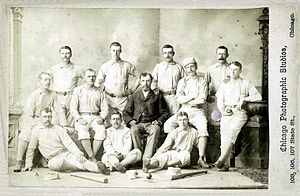
1882 Providence Grays
The Providence Grays were a Major League Baseball franchise based in Providence, Rhode Island from 1878 to 1885. During the team's eight seasons in the National League (NL), which then comprised eight teams, they finished third place or higher in the final standings seven times, and won the league championship in both 1879 and 1884. Providence played their home games at the Messer Street Grounds, which was located in the Olneyville neighborhood of Providence. The Grays were officially organized on January 16, 1878 by Benjamin Douglas, who became the team's general manager. Henry Root was hired as the team president‚ and Tom Carey was initially hired to be the on-field captain, whose duties were similar to the modern-day manager. On January 21, 1878, Providence applied for membership in the NL, and was officially approved on February 6. On April 10, Root took over ownership of the team, fired Douglas for incompetence and insubordination, and hired Tom York to replace Carey as captain.
Providence was successful in signing several star players for their inaugural season: Paul Hines had played the previous four seasons with the Chicago White Stockings; Tom Carey was signed after the Hartford Dark Blues folded; Doug Allison was the catcher for the 1869 Cincinnati Red Stockings, who had an 84-game winning streak from 1869 to 1870; and John Montgomery Ward, who was playing his first season in the major leagues. Ward had a win–loss record of 22–13 and Hines led the league in home runs, runs batted in (RBIs), and batting average as the Grays finished in third place among the six teams in the NL for the 1878 season, with a record of 33 wins, 27 losses, and 2 ties. The Grays won the NL championship in 1879, placing first among the league's eight teams with Ward winning 47 games as their starting pitcher, and the leadership of George Wright, who played second base and also managed. The team had a strong hitting line-up with Hines' league leading .357 batting average, as well as new additions Jim O'Rourke and Joe Start, who both had batting averages over .300. William Edward White, a Brown University player who played one game for the Grays on June 21, 1879, may have been the first African-American to play at the major league level; according to Peter Morris of the Society for American Baseball Research, the evidence for White is strong, but not conclusive. If this claim is true, then White pre-dated both Moses Fleetwood Walker and his brother Weldy Walker, who both played for the 1884 Toledo Blue Stockings of the American Association (AA). In 1880, the Grays finished in second place among the eight NL teams, with Ward winning 39 games. On June 17 of that year, Ward pitched the second perfect game in major league history. (Full article...) -
Image 4
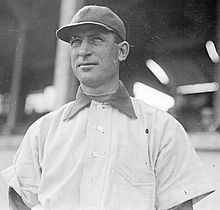
Fred Clarke, the winningest manager in Pirates history; he led the team to 1,422 victories along with a World Series title and four National League pennants.
The Pittsburgh Pirates are a Major League Baseball (MLB) franchise based in Pittsburgh, Pennsylvania. They play in the National League Central division. The team began play in 1882 as the Alleghenies (alternatively spelled "Alleghenys") in the American Association. The franchise moved to the National League after owner William Nimick became upset over a contract dispute, thus beginning the modern day franchise. The team currently plays home games at PNC Park which they moved into in 2001. Prior to PNC Park, the Pirates played games at Three Rivers Stadium and Forbes Field, among other stadiums.
There have been 46 managers for the Pittsburgh Pirates franchise. The Pirates' first manager upon joining the National League was Horace Phillips, who had coached the team before their move to the National League. In 1900, Fred Clarke began his tenure with the franchise. Clarke's 1422 victories and 969 losses lead all managers of the Pirates in their respective categories, Clarke also had the longest tenure as manager in his 16 years in the position. Clarke managed the franchise to its first World Series victory, a feat that would also be accomplished by Bill McKechnie, Danny Murtaugh, and Chuck Tanner. Thirteen Pirates managers have been player-managers—those who take on simultaneous roles as a player and manager. McKechnie, Connie Mack, and Ned Hanlon were inducted into the National Baseball Hall of Fame and Museum as managers. Five Pirates managers were inducted into the Hall of Fame for their performance as players. Billy Meyer's number 1, Pie Traynor's number 20, Honus Wagner's number 33, and Murtaugh's number 40 have been retired by the franchise. Hired before the 2020 season, the Pirates' current manager is Derek Shelton. (Full article...) -
Image 5

Mike Piazza is the all-time leader in Silver Slugger Awards among catchers, winning ten consecutive from 1993 to 2002.
The Silver Slugger Award is awarded annually to the best offensive player at each position in both the American League (AL) and the National League (NL), as determined by the coaches and managers of Major League Baseball (MLB). These voters consider several offensive categories in selecting the winners, including batting average, slugging percentage, and on-base percentage (OBP), in addition to "coaches' and managers' general impressions of a player's overall offensive value." Managers and coaches are not permitted to vote for players on their own team. The Silver Slugger was first awarded in 1980 and is given by Hillerich & Bradsby, the manufacturer of Louisville Slugger bats. The award is a bat-shaped trophy, 3feet (91cm) tall, engraved with the names of each of the winners from the league and plated with sterling silver.
Among catchers, Mike Piazza has won the most Silver Slugger Awards, with ten consecutive wins in the National League between 1993 and 2002; this is the most Silver Sluggers won consecutively by any player in Major League Baseball. In the American League, Iván Rodríguez has won the most Silver Sluggers, with six consecutive wins from 1994 to 1999, and a seventh when he tied with Víctor Martínez in 2004. Lance Parrish won the American League award six times (1980, 1982–1984, 1986, and 1990), and Joe Mauer, Jorge Posada and Salvador Pérez have won it five times; Mauer won in 2006, 2008–2010 and 2013, Posada won in 2000–2003 and 2007, and Pérez won it in 2016, 2018, 2020, 2021 and 2024. Hall of Famer Gary Carter (1981–1983, 1984–1986), Buster Posey (2012, 2014–2015, 2017, 2021), and Brian McCann (2006, 2008–2011) are five-time winners in the National League; McCann also won a sixth Silver Slugger in 2016, but in the American League. Other multiple awardees include Benito Santiago (four wins; 1987–1988, 1990–1991), J. T. Realmuto (three wins; 2018–2019, 2022), Mickey Tettleton (three wins; 1989, 1991–1992) and Carlton Fisk (three wins; 1981, 1985, 1988). William Contreras and Salvador Pérez are the most recent National and American League winners, respectively. (Full article...) -
Image 6

Ben Sheets made six Opening Day starts for the Brewers, a franchise record.
The Milwaukee Brewers are a Major League Baseball team based in Milwaukee, Wisconsin. They play in the National League Central division. Established in Seattle, Washington, as the Seattle Pilots in 1969, the team became the Milwaukee Brewers after relocating to Milwaukee in 1970. The first game of the new baseball season for a team is played on Opening Day, and being named the Opening Day starting pitcher is an honor which is given to the player who is expected to lead the pitching staff that season, though there are various strategic reasons why a team's best pitcher might not start on Opening Day. The Brewers have used 34 different Opening Day starting pitchers in their 56 seasons.
The Pilots, whose home ballpark was Sick's Stadium, played their inaugural Opening Day game on the road against the California Angels at Anaheim Stadium in Anaheim, California, on April 8, 1969. Marty Pattin was their starting pitcher that day; he earned the win in a game the Pilots won, 4–3. In 1970, the team relocated to Wisconsin and began playing their home games at Milwaukee County Stadium. The Brewers opened their first season in Milwaukee at home with Opening Day starter Lew Krausse Jr. taking the loss in a 12–0 defeat by the California Angels on April 9. County Stadium was home to the Brewers for 31 seasons through 2000. Their final Opening Day game at the facility occurred on April 26, 1995. Starter Ricky Bones took a no decision in the Brewers' 12–3 win over the Chicago White Sox. Steve Woodard received an unusual no decision in 2000, when the team's Opening Day game against the Cincinnati Reds was called in the sixth inning due to rain, with the score tied at 3. The team moved into American Family Field, then known as Miller Park, in 2001, but they did not play their first Opening Day game at the new stadium until five years later. In that game, held on April 3, 2006, Milwaukee defeated the Pittsburgh Pirates, 5–2; starter Doug Davis did not figure in the decision. (Full article...) -
Image 7
The Branch Rickey Award was given annually to an individual in Major League Baseball (MLB) in recognition of his exceptional community service from 1992 to 2014. The award was named in honor of former player and executive Branch Rickey, who broke the major league color barrier by signing Jackie Robinson, while president and general manager of the Brooklyn Dodgers. Rickey also created the Knothole Gang, a charity that allowed children to attend MLB games.
The award, created by the Rotary Club of Denver in 1991, was first awarded to Dave Winfield in 1992 at their annual banquet. Each MLB team nominates one individual who best exemplifies the Rotary Club motto: "Service Above Self". A vote is then conducted by the national selection committee, which consists of members of the sports media, previous winners of the award, and Rotary district governors in major league cities. Proceeds of the banquet benefit Denver Kids, Inc., a charity for at-risk students who attend Denver Public Schools. Each winner receives a bronze sculpture of a baseball player measuring 24 inches (610 mm), named "The Player", designed by sculptor George Lundeen. A larger version of "The Player", standing 13 feet (4.0 m) tall, was erected at Coors Field in Denver. (Full article...) -
Image 8The Miami Marlins are a professional Major League Baseball based in Miami, Florida. The Marlins are members of the National League East division in MLB, joining in 1993 as an expansion team. In baseball, the head coach of a team is called the manager, or more formally, the field manager. The duties of the team manager include team strategy and leadership on and off the field. The Marlins have employed fifteen different managers (two interim) since their founding as the Florida Marlins in 1993, with three leading then to the postseason that has resulted in two World Series championships (1997, 2003).
The Marlins' first manager was Rene Lachemann, who led the team from its creation in 1993 through part of the 1996 season. After Cookie Rojas managed for one game, John Boles served as manager for the final 75 games of the 1996 season. Jim Leyland took over the franchise for the next two seasons, and in the process led the Marlins to their first World Series championship in 1997. In 1999, Boles took over and started his second stint as manager of the Marlins, which lasted until partway through the 2001 season. Tony Pérez was interim manager for the rest of 2001; Pérez is the only Miami Marlins manager who is a member of the National Baseball Hall of Fame, inducted as a player in 2000. (Full article...) -
Image 9
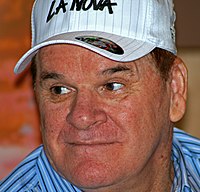
Pete Rose is the all-time MLB hits leader with 4,256 hits.
The 3,000-hit club is the group of 33 batters who have collected 3,000 or more regular-season hits in their careers in Major League Baseball (MLB). Reaching 3,000 hits has been "long considered the greatest measure of superior bat handling" and is often described as a guarantee of eventual entry into the Baseball Hall of Fame.
Cap Anson was the first MLB player to reach 3,000 hits, although his precise career hit total is unclear. Two players—Nap Lajoie and Honus Wagner—reached 3,000 hits during the 1914 season. Ty Cobb did so in 1921 and became the first player in MLB history to reach 4,000 hits in 1927, ultimately finishing his career with 4,191. Pete Rose, the current hit leader, became the second player to reach 4,000 hits on April 13, 1984, and surpassed Cobb in September 1985, finishing his career with 4,256. Roberto Clemente's career ended with precisely 3,000 hits, which he reached in the last at bat of his career on September 30, 1972. (Full article...) -
Image 10
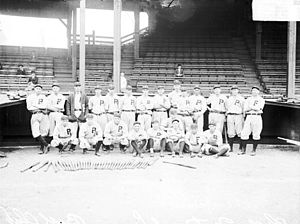
The 1915 Phillies were the first in franchise history to win the National League pennant.
This is a list of seasons completed by the Philadelphia Phillies, originally known as the Philadelphia Quakers, a professional baseball franchise based in Philadelphia, Pennsylvania.
The Philadelphia Phillies have completed 131 seasons in Major League Baseball since their inception in 1883. (Full article...) -
Image 11

Cole Hamels, the Phillies' first-round pick in 2002
The Philadelphia Phillies are a Major League Baseball franchise based in Philadelphia, Pennsylvania. They play in the National League East division. Since the institution of Major League Baseball's Rule 4 Draft, the Phillies have selected 51 players in its first round. Officially known as the "First-Year Player Draft", the Rule 4 Draft is Major League Baseball's primary mechanism for assigning amateur baseball players from high schools, colleges, and other amateur baseball clubs to its teams. The draft order is determined based on the previous season's standings, with the team possessing the worst record receiving the first pick. In addition, teams which lost free agents in the previous off-season may be awarded compensatory or supplementary picks.
Of the 51 players picked in the first round by the Phillies, 26 have been pitchers, the most of any position; 20 of these were right-handed, while 6 were left-handed. Nine players picked in the initial round were outfielders, while six catchers, four first basemen, and four shortstops were selected. The team also selected one player each at second base and third base. Thirteen of the 45 players came from high schools or universities in the state of California, while Texas and Florida follow, with six and five players, respectively. (Full article...) -
Image 12

Bill Virdon is the all-time winningest manager in Astro history; he won 544 games while leading the Astros to their first postseason berth in 1980 and two division titles.
The Houston Astros are a professional baseball franchise based in Houston, Texas. They are a member of the American League West Division in Major League Baseball. The team joined MLB in 1962 as an expansion team named the Houston Colt .45s and changed their name to the Houston Astros in 1965. The team won their first NL Championship in 2005. Having first played in Colt Stadium (1962–1964), and later in The Astrodome, now known as the Reliant Astrodome (1965–1999), the Astros have played their home games at Minute Maid Park, which was first named The Ballpark at Union Station, since 2000. The current manager is Joe Espada.
There have been 25 managers for the Astros franchise. The team's first manager was Harry Craft, who managed for three seasons. Bill Virdon is the franchise's all-time leader for the most regular-season games managed (1066) and the most regular-season game wins (544). Dusty Baker is the franchise's all-time leader in career playoff games managed (53) and playoff games won (34). Salty Parker is the Astros' all-time leader for the highest regular-season winning percentage, as he has only managed one game, which he won. Of the managers who have managed a minimum of 162 games (one season), Baker has the highest regular-season winning percentage with .594. Leo Durocher is the only Astros manager to have been elected into the Baseball Hall of Fame. Durocher and Baker each achieved their 2,000th managerial win with the Astros. Garner, Hinch, and Baker are the only managers to have won league pennants with the franchise, Garner winning one in the National League in 2005, Hinch winning two in the American League in 2017 and 2019, and Baker winning two in 2021 and 2022. Larry Dierker is the only Astros manager to have had his uniform number retired by the Astros, with his uniform number 49 retired by the Astros in 2002. Dierker is also the sixth manager in MLB history to win a division championship in his first season for the Astros in 1997. Lanier and Dierker are the only managers to have won a Manager of the Year Award with the Astros, winning it in 1986 and 1998 respectively. Grady Hatton, Lanier, Dierker, and Cooper have spent their entire managing careers with the Astros. (Full article...) -
Image 13

Walter Johnson holds the record with 12 different seasons that he was a strikeout leader, including 8 consecutive from 1912 through 1919. Johnson was one of the five charter members of the Baseball Hall of Fame.
In baseball, the strikeout is a statistic used to evaluate pitchers. A pitcher earns a strikeout when he puts out the batter he is facing by throwing a ball through the strike zone, "defined as that area over homeplate (sic) the upper limit of which is a horizontal line at the midpoint between the top of the shoulders and the top of the uniform pants, and the lower level is a line at the hollow beneath the kneecap", which is not put in play. Strikeouts are awarded in four situations: if the batter is put out on a third strike caught by the catcher (to "strike out swinging" or "strike out looking"); if the pitcher throws a third strike which is not caught with fewer than two outs; if the batter becomes a baserunner on an uncaught third strike; or if the batter bunts the ball into foul territory with two strikes.
Major League Baseball recognizes the player or players in each league[a] with the most strikeouts each season. Jim Devlin led the National League in its inaugural season of 1876; he threw 122 strikeouts for the Louisville Grays. The American League's first winner was Hall of Fame pitcher Cy Young, who captured the American League Triple Crown in 1901 by striking out 158 batters, along with leading the league in wins and earned run average. Walter Johnson led the American League in strikeouts twelve times during his Hall of Fame career, most among all players. He is followed by Nolan Ryan, who captured eleven titles between both leagues (nine in the American League and two in the National League). Randy Johnson won nine strikeout titles, five coming with the Arizona Diamondbacks. Three players have won seven strikeout championships: Dazzy Vance, who leads the National League; Bob Feller; and Lefty Grove. Grover Cleveland Alexander and Rube Waddell led their league six times, and five-time winners include Steve Carlton, Roger Clemens, Sam McDowell, Christy Mathewson, Amos Rusie, and Tom Seaver. (Full article...) -
Image 14

Roy Halladay (1995) is the only Blue Jays' first-round pick to be inducted into the Baseball Hall of Fame, and to win a Cy Young Award with the team.
The Toronto Blue Jays are a Major League Baseball (MLB) franchise based in Toronto, Ontario, Canada. They play in the American League East division. Since the Blue Jays' entrance into the league in 1977, the Blue Jays have selected 72 players in the first round. Officially known as the "First-Year Player Draft", the Rule 4 draft is MLB's primary mechanism for assigning amateur players from high schools, colleges, and other amateur clubs to its teams. The draft order is determined based on the previous season's standings, with the team possessing the worst record receiving the first pick. In addition, teams which lost free agents in the previous off-season may be awarded compensatory or supplementary picks. The First-Year Player Draft is unrelated to the 1976 expansion draft in which the Blue Jays initially filled their roster.
Of the 72 players picked in the first round by Toronto, 35 have been pitchers, the most of any position; 26 of them were right-handed, while nine were left-handed. 14 shortstops, 12 outfielders, four catchers and third basemen, and three first basemen have also been selected. The team has never drafted a player at second base in the first round. 38 players were drafted out of high school, while 31 came from four-year college programs and two from junior colleges. They have also drafted two players from Puerto Rico: Alex Ríos (1999) and Miguel Negrón (2000). (Full article...) -
Image 15
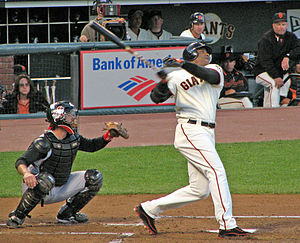
Barry Bonds, the all-time career home run leader in Major League Baseball, led the league in home runs twice including in 2001 when he set the record single-season mark
In baseball, a home run is scored when the ball is hit so far that the batter is able to circle all the bases ending at home plate, scoring himself plus any runners already on base, with no errors by the defensive team on the play. An automatic home run is achieved by hitting the ball on the fly over the outfield fence in fair territory. More rarely, an inside-the-park home run occurs when the hitter reaches home plate while the baseball remains in play on the field. In Major League Baseball (MLB), a player in each league[L] wins the home run title each season by hitting the most home runs that year. Only home runs hit in a particular league count towards that league's seasonal lead. Mark McGwire, for example, hit 58 home runs in 1997, more than any other player that year. However, McGwire was traded from the American League's (AL) Oakland Athletics to the National League's (NL) St. Louis Cardinals midway through the season and his individual AL and NL home run totals (34 and 24, respectively) did not qualify to lead either league.
The first home run champion in the National League was George Hall. In the league's inaugural 1876 season, Hall hit five home runs for the short-lived National League Philadelphia Athletics. In 1901, the American League was established and Hall of Fame second baseman Nap Lajoie led it with 14 home runs for the American League Philadelphia Athletics. Over the course of his 22-season career, Babe Ruth led the American League in home runs twelve times. Mike Schmidt and Ralph Kiner have the second and third most home run titles respectively, Schmidt with eight and Kiner with seven, all won in the National League. Kiner's seven consecutive titles from 1946 to 1952 are also the most consecutive home run titles by any player. (Full article...)
More did you know
- ... that brothers George Wright and Harry Wright both managed the Providence Grays National League baseball team?
- ... that Mike Cather earned his first major-league win in an 11-inning Atlanta Braves’ win, the same night the Braves earned the National League Eastern Division title?
- ... that in 1975, his only full season, Stan Perzanowski's earned run average was the lowest on the Texas Rangers?
- ... that Josh Gibson Field in Pittsburgh, Pennsylvania, is named for Negro League star Josh Gibson, who has been called the "black Babe Ruth?"
- ... that Ryota Igarashi used to hold the Nippon Professional Baseball record for the fastest pitch thrown?
Sports portals
Selected picture
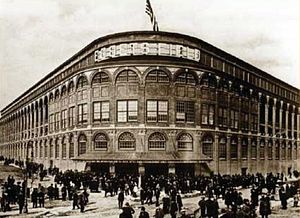
| Credit: Unknown |
Ebbets Field was a Major League Baseball park located in the Flatbush section of Brooklyn, New York. It was the home of the Brooklyn Dodgers of the National League. Two different incarnations of a Brooklyn Dodgers football team also played at the stadium. The park opened on April 9, 1913, and was demolished in 1960, three years after the team relocated to Los Angeles.
Associated Wikimedia
The following Wikimedia Foundation sister projects provide more on this subject:
-
Commons
Free media repository -
Wikibooks
Free textbooks and manuals -
Wikidata
Free knowledge base -
Wikinews
Free-content news -
Wikiquote
Collection of quotations -
Wikisource
Free-content library -
Wikiversity
Free learning tools -
Wiktionary
Dictionary and thesaurus
More portals
- Portals with triaged subpages from June 2018
- All portals with triaged subpages
- Portals with no named maintainer
- Automated article-slideshow portals with 51–100 articles in article list
- Automated article-slideshow portals with 501–1000 articles in article list
- Random portal component with 41–50 available subpages
- Automated article-slideshow portals with 201–500 articles in article list
- Random portal component with 11–15 available subpages
- Random portal component with 21–25 available image subpages





